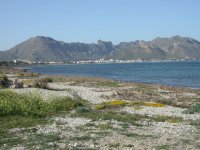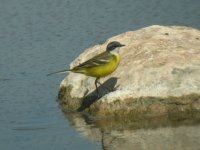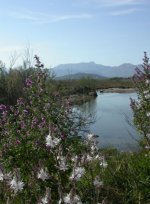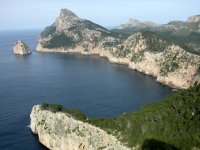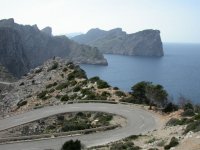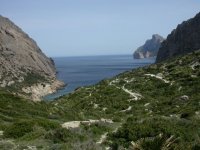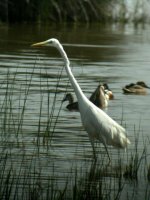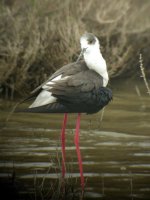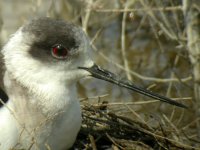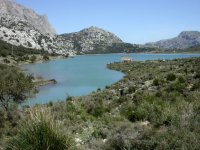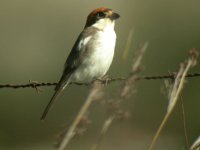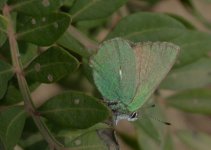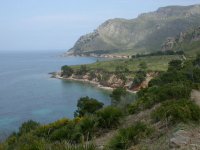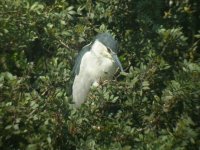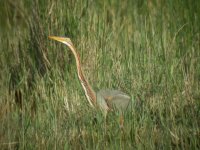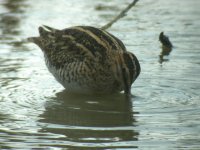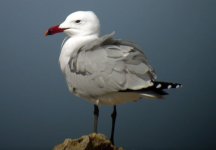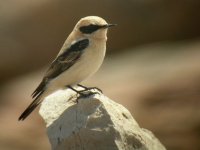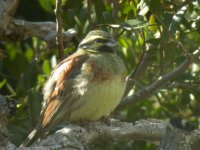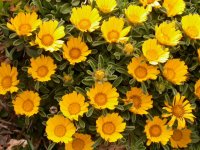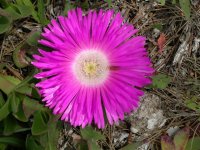Monday 10th April
Actually set an alarm this morning, so we had time to get down to the south-east corner of the island. The drive to Cap de Ses Selines was uneventful through attractive farmland, and we arrived mid morning to a beautiful turquoise sea, a very showy Audouin’s Gull and numerous handsome Black-eared Wheatears. The coastal garrigue habitat was stunning, full of wildflowers and birds – I could have happily wandered around here all day. Walking along by the sea, a Hobby came in off, and rather bizarrely, a Purple Heron circled overhead – perhaps this was newly arrived from further south as well? Way out to sea, I could pick out a few Cory’s Shearwaters – really glad I saw them close at Formentor, though, since the views here were pretty awful in truth.
A mile or two inland from the point, we saw several larks on the high roadside walls, so I pulled over to investigate. I kept hearing an unfamiliar song amongst all the Corn Buntings, but eventually figured it out and got views of Short-toed Lark – a bird I haven’t seen for a long time. We drove through Colonia de Sant Jordi, and had a look at the salt pans there – a few Audouin’s Gulls loafed about, and the ever-present Black-winged Stilts were noisily flying about.
Quickly moving on, the next stop was the large area of saltpans at Salinas de Llevante – what a fantastic site that turned out to be (though arguably not the most attractive)! It held a considerably wider range of waders than the Albufera, including Grey and Ringed Plover, Avocets, close to 100 Little Stints, Curlew and Redshank. However, the undoubted highlight was a group of ten Greater Flamingos – after initially poor views of just their heads in the distance, they were spooked by a Marsh Harrier, and flew about for a while. Coming back in to land, they provided great comedy value, waving long necks, legs and wings in various apparently random directions, looking completely out of control! Two Whiskered Terns showed rather poorly, the only marsh terns of the trip. It’s a shame that the Salinas are so far from the main birding areas in the north of the island – given more time there, I was sure there was plenty more to see.
Tuesday 11th April
Another rather touristy day, heading out to the east coast to visit the Coves del Drach (show caves with spectacular stalactitite and stalagmite formations… and dreadfully cheesy classical music by boat). After wandering round the nearby aquarium, we drove down to Porto Colom, another site from Graham Hearl’s book, hoping to see Pallid Swifts. Once again, no luck with this species – I guess it’s too early in the season to find them at breeding sites. However, we did see Thekla Lark here near the carpark, and Cory’s and Balearic Shearwaters offshore.
Heading inland on the return, we drove up the tiny lane to the Castel de Santueri, and enjoyed the Crag Martin colony. Suzanne’s sharp eyes quckly picked up an Alpine Swift disappearing into the distance, so we waited for quite a while to try and get better views – eventually I saw at least four, though never particularly close. A Peregrine was also drifting about here.
The next stop, the Ermita de Sant Salvador, was well worth a visit for the stunning 360-degree views – you could see almost the entire island from here. A sobering thought at the time concerned “if you put London and all its suburbs on Mallorca, what would be left untouched?” Answer: not a lot… the island is deceptively small (or perhaps London is mind-bogglingly large?)
On the way home, it seemed a shame to drive past S’Albufera and not call in, so we had a quick wander down to the visitor centre, and were rewarded with at least one Red-rumped Swallow in vast numbers of hirundines. Many were feeding over the Ses Puntes track, and having walked along there, the sight was truly spectacular. The Night Heron counted was stable at 28 alongside the canal on the way back.
Wednesday 12th April
We’d decided that the last day should be devoted to re-visiting our favourite places from the entire trip – the Bocquer valley and S’Albufera were easy choices to make! As it turned out, both were rather quiet, though another birder I spoke two had seen a Spectacled Warbler in the valley earlier on. I couldn’t find anything to take the trip list on beyond 116, but wandering around these two fantastic sites was enjoyable enough without needing anything spectacular.




